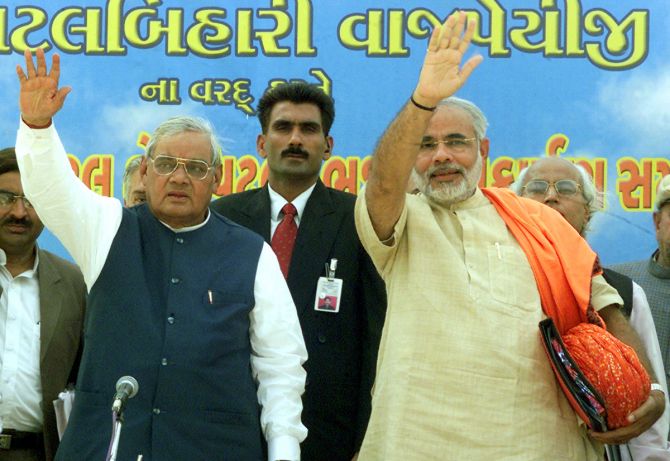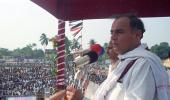Gujarat was labelled Hindutva's crucible and Modi was to become the chief 'chemist'.
A revealing political saga excerpted from Nilanjan Mukhopadhyay's The Demolition, the Verdict and the Temple: The Definitive Book on the Ram Mandir Project.

As early as October-November 1989, much before Gujarat began being referred to as Hindutva's laboratory, Modi had concluded that the Ayodhya agitation had opened the gates of electoral success for the BJP in Gujarat.
Although secretary of the state unit, he was relatively junior at 39. His viewpoint, that the BJP should contest parliamentary elections independently, and not in alliance with the Janata Dal, was turned down by seniors, Advani included.
During negotiations, Modi wanted parity -- 26 parliamentary seats from the state apportioned equally. Others, unsure of the public appeal for the Ram temple agitation's timbre, agreed to 12 seats that the Janata Dal was willing to give it.
Modi's confidence was not ill-founded -- the BJP won each seat it contested, while the JD lost three of the 14 it fought. Having scored a point within his party, Modi was elevated as principal negotiator for the assembly elections in February 1990.
Talks broke down because of his insistence on equal sharing of seats. Central leaders intervened and sewed a flawed alliance with the two allies contesting against one another in more than fifty seats.
Yet, post-verdict, the two decided to collaborate because between them they had a clear majority. The Janata Dal nominee, Chimanbhai Patel, became chief minister.
In recognition of his political reading and organizational capacities, Modi was promoted as general secretary (organization) of the Gujarat unit. In due course, he was asked to anchor the Gujarat leg of Advani's Ram Rath Yatra.
Nine months later, when fresh parliamentary polls were necessitated in 1991, the BJP improved its tally astonishingly -- winning 20 out of the 26 seats in Gujarat with a vote share of 50.2 per cent. By then, the BJP had snapped ties with the Janata Dal and walked out of the state government.
The 'political Hindu', enthused by the idea of the Ram temple, had unquestionably reared its head. Gujarat was labelled Hindutva's crucible and Modi was to become the chief 'chemist'.

At its annual meeting in March 2001, the Akhil Bharatiya Pratinidhi Sabha of the RSS 'endorsed' the VHP's plan to revive the Ayodhya movement.
A resolution stated that the Vajpayee government had been given 'sufficient time for the government to do away with the hurdles needlessly obstructing the temple construction over almost a decade' and that the 'ball is now in the government's court'.
The plan was an encore of the 1989 and 1992 campaigns, involving a fusion of three elements. First, innovative Hindu worship rituals on the lines of shila pujan, shilanyas, etc, in which people were motivated to participate.
The second feature was an ostensibly religious yatra but which was essentially a political march. The
last element was providing the cadre and neo-converts the illusion of participating in the construction of the Ram temple, although this is a professional task requiring people with specific skills working under adequate technical supervision.

A three-month-long countrywide mass mobilization drive was scheduled between 18 October 2001 and 18 January 2002. It was to be resumed on 24 February in Ayodhya and slated to continue for the next hundred days.
The first leg, named Shri Ram Naam Jap Yagna, was a drive to marshal people on the lines of the 1989 initiative of daily Ram bhajans in temples in villages, towns and cities. In 2001, a special stotra or hymn to pay obeisance to Lord Ram was written.
Community as well as personal chanting of the mantra, especially composed for construction of a Ram temple, spawned a sense of civic participation among Hindus who turned out for these. Those who chanted the mantra without pause for 65 days qualified to participate in the next phase of the programme.
These qualifiers were provided tridents, saffron headbands and Ram Sevak identity cards, adornments of pride. Community chanting started in Gujarat days after Modi assumed charge as chief minister in October 2001.
Nearly 2000 volunteers who qualified from the state left for Ayodhya on 22, 24 and 26 February 2002. They were to participate in the second phase of the specially conceived ritual, the Purnahuti Yagna, before returning to make way for the next group of qualifiers or Ram sevaks from another state.

Starting 24 February, this second phase of ritual worship was to go on for a hundred days, by when the construction was supposed to start.
The Purnahuti Yagna was certainly confrontational in character because kar seva was to begin from 15 March and unless the judicial directive on status quo in the entire government-controlled 67 acres of land was altered by the Supreme Court, the government would have to deploy forces to halt the programme and force VHP activists to vacate the site of the ritual.
The second element of the temple agitation revival package in 2001 was the yatra or political pilgrimage. Uncharacteristically, it was a low-key affair because the VHP was focused on mobilizing masses for the Ayodhya programme.
Consequently, the Sant Chetawani Yatra or the march to serve a warning from holy men had Ashok Singhal at its head, with almost 3,000 saffron-clad sadhus in tow.
This Ayodhya to Delhi march flagged off on 21 January 2002 and reached the Indian capital symbolically on Republic Day, 26 January.
They met Vajpayee the next day and he pleaded with the religious leaders to give the government more time to find a way out.

The third element of this confrontationist line-up in 2001-2002 was kar seva or construction from 12 March.
The principal demand was that the government must find means, prior to this date, to segregate disputed and undisputed portions of the 67 acres of land in government control. This phase, however, never got under way.
The VHP leadership was aware that starting to build the temple was no ordinary matter and they created several smokescreens to convey to the restive cadre that 'progress' was being made.

Modi was sworn in as Gujarat chief minister days prior to the launch of the three-pronged plan of the VHP. He was well aware of rising communal tension in the state as selected Ram Sevaks headed for Ayodhya on trains.
The first batch reached the temple town on 24 February. After participating in the Purnahuti Yagna on 25 February, they boarded the Sabarmati Express to return to Gujarat. The train reached Godhra station on 27 February minutes before 8 am What happened subsequently requires little reiteration.
Without being present in Ayodhya in February-March 2002, Modi benefited the most from the gory fate that returning Ram Sevaks met with at Godhra.
Excerpted from The Demolition, the Verdict and the Temple: The Definitive Book on the Ram Mandir Project by Nilanjan Mukhopadhyay, with the kind permission of the publishers, Speaking Tiger.










